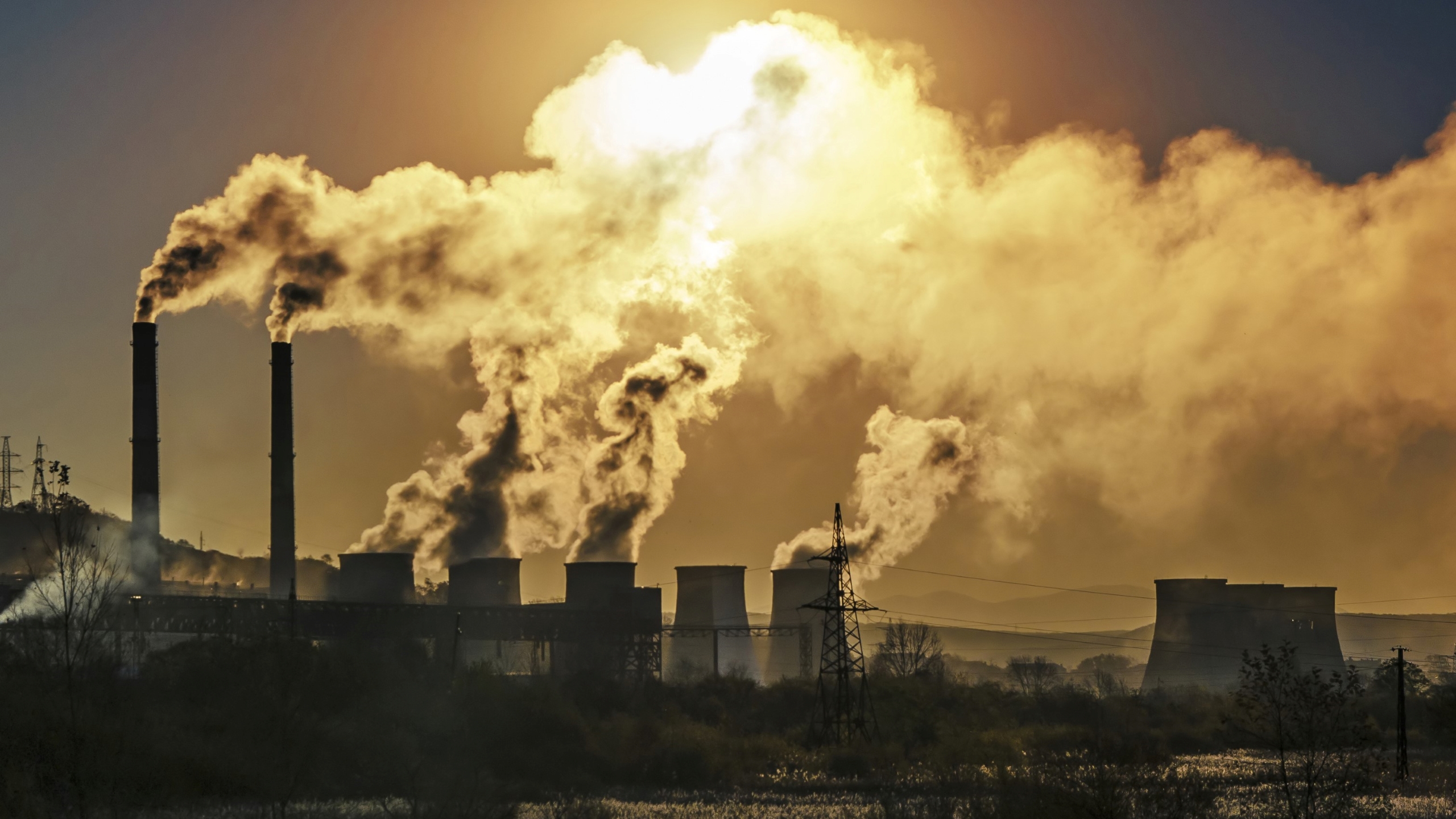Introduction to the topic
Introduction to the problem of fires in southern Europe
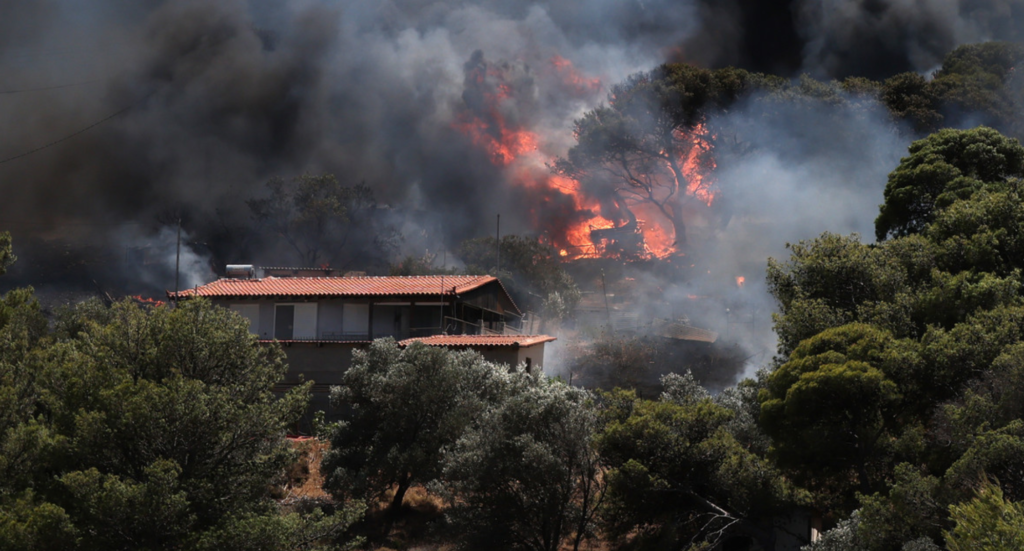
Southern Europe is a particularly fire-prone area for a variety of reasons. First and foremost, the Mediterranean climate is characterized by hot, dry summers and mild, rainy winters, which is conducive to the occurrence of fires, especially in summer, when high temperatures and low humidity create favorable conditions for fire spread.
Climate change is further aggravating the situation by causing more frequent and intense heat waves. Increased average temperatures and irregular rainfall make forests drier, increasing the risk of fire. In addition, climate change can extend the fire season and increase its intensity.
In addition to natural factors, human activities also increase the risk of fires. Urbanization, improper management of green and agricultural lands, and accidental arson are all elements that can lead to fires. In tourist regions, where there are many people in the summer, the risk of accidental fire ignition increases.
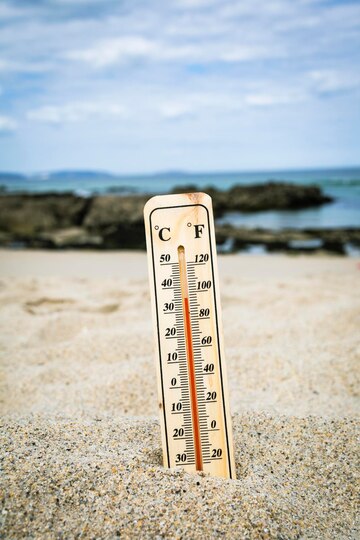
The increasing risk of wildfires has serious consequences for people, the environment and the economy. Fires destroy natural ecosystems, threaten biodiversity and emit large amounts of carbon dioxide into the atmosphere, accelerating climate change. For local communities, they threaten life and property, and cause economic losses, especially in tourism and agriculture.
In order to effectively combat fires, it is necessary to implement comprehensive forest management strategies that include both preventive measures and rapid response to emerging incidents. An important element is educating the public and raising awareness of fire risks and appropriate behavior in the face of such risks. International cooperation and investment in modern fire monitoring and suppression technologies can play a key role in protecting the region from this growing problem.
History and statistics of fires in Greece and other countries in the region
The history of fires in Greece has its roots in antiquity, but in recent years the problem has become more acute due to climate change and urbanisation. In the 20th century, fires started to occur with greater frequency and their intensity increased significantly, especially in summer.
Recent data show a dramatic increase in the number of fires in Greece. In 2021, the country struggled with some of the most severe fires in years, destroying thousands of hectares of forest and forcing many people to evacuate. On average, it is estimated that around 1,500 fires break out in Greece every year, covering an area of more than 50,000 hectares. The fire season, which lasts from June to September, is particularly dangerous due to high temperatures and strong winds.
The problem of large fires in Greece was particularly exacerbated in the late 1990s and early 2000s, when climate change began to have a significant impact on the region. In 2007, some of the most tragic fires in the country’s history took place, costing dozens of lives and destroying many villages and towns.
Comparing Greece’s situation with other Mediterranean countries such as Spain, Portugal and Italy, it is clear that the entire region is facing similar problems. Rising temperatures, droughts and neglect of traditional agricultural and forestry practices increase the risk of fires. Joint international initiatives, such as cooperation within the European Union, aim to improve preparedness and response to fire hazards, which is key to protecting people and the environment.
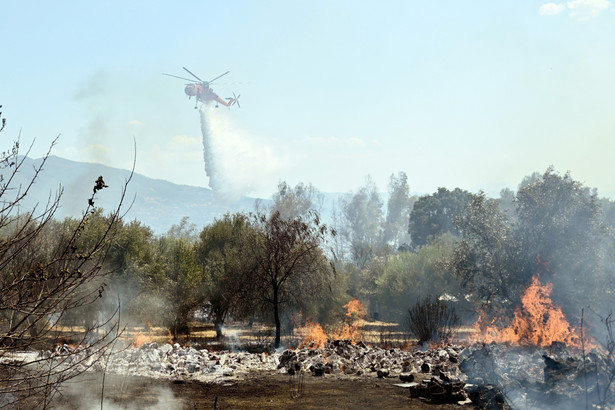
Impact of seasonality and weather conditions
Seasonality is key to fire risk, and the summer period is particularly critical. High temperatures, prolonged drought and strong winds create conditions conducive to the rapid spread of fire, posing a serious threat to ecosystems, property and human life.
In summer, when temperatures peak, humidity decreases and the soil becomes dry, increasing the flammability of vegetation. Under such conditions, even the smallest spark can lead to a fire. In addition, droughts caused by a lack of rainfall lead to a reduction in water resources, making firefighting efforts more difficult.
Strong winds, which often occur during summer storms, pose an additional challenge. They can accelerate the spread of flames to new areas, making it difficult to control the fire. Winds can also carry sparks over considerable distances, initiating new fire outbreaks in areas that seemed safe.
In the context of a changing climate, phenomena such as heat waves and extreme weather conditions are becoming more common, increasing the risk of wildfires. It is therefore important for societies to take preventive measures, such as monitoring weather conditions, banning forest fires in times of drought and educating residents about the dangers of fires.
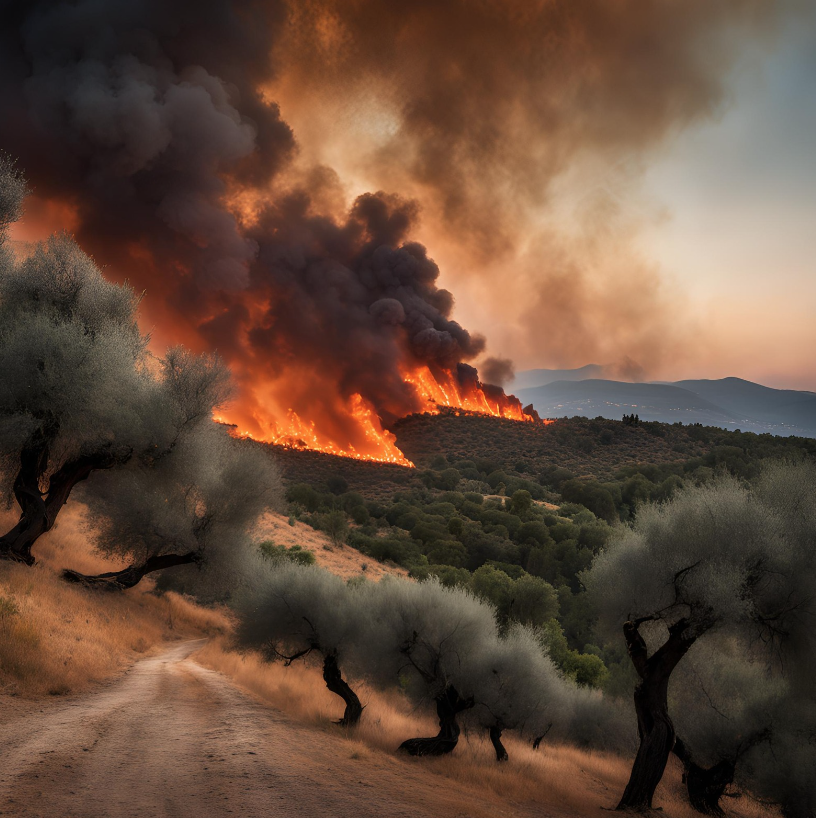
Causes of fires in Greece
Natural causes of fires
Fires can be caused by a variety of factors, including natural causes. Such causes include spontaneous combustion, lightning strikes and certain weather conditions, such as hot winds and dry storms, which can increase the risk of fire.
Spontaneous combustion is a phenomenon in which organic matter, for example leaves, wood or other organic substances, heats up to such an extent that it begins to burn without an external fire source. This process is the result of natural chemical reactions that can occur as a result of prolonged exposure to sunlight or moisture. High temperatures and sufficient humidity can lead to fermentation and oxidation, resulting in spontaneous combustion. In many parts of the world, especially in forests, cases of spontaneous combustion occur especially in summer, when conditions are most favourable.
Lightning is another natural trigger for fires. Lightning strikes, especially during thunderstorms, can ignite trees, grasses and other flammable materials. When lightning strikes the earth’s surface, it generates an enormous amount of heat, which can be enough to ignite surrounding substances. Lightning is one of the main causes of fires in forests and open areas, especially in areas where there are long periods of drought.
Specific atmospheric conditions, such as hot winds and dry thunderstorms, also play a key role in the occurrence of fires. Hot winds, which often accompany high temperatures, can spread fires quickly, bringing sparks with them from one place to another. These winds are particularly dangerous as they can occur in regions where the soil is already dry and prone to ignition. Similarly, dry thunderstorms, which are characterised by a lack of rain but intense lightning, can lead to situations where there is a high risk of fire.
Man as the main cause of fires
Man plays an important role in the occurrence of fires, which have serious environmental, public health and economic consequences. Careless handling of fire is one of the main causes of fires that occur in both rural and urban areas. Many people, especially in spring, engage in grass burning, which is not only dangerous but also illegal in many countries. Such activities can quickly get out of hand, leading to fires spreading over large areas, endangering valuable green spaces and threatening lives and property.
Another important factor contributing to the increase in the number of fires is arson, both intentional and accidental. Intentional arsons, often resulting from a desire for revenge, a desire for profit or simply boredom, can lead to disastrous consequences. They often end not only in the destruction of property, but also in the deaths of people and animals. Accidental arson, on the other hand, caused, for example, by children playing with fire or careless adults, can also lead to serious tragedies. In both cases, man is the source of the problem and the effects of his actions can be tragic.Man plays an important role in the occurrence of fires, which have serious environmental, public health and economic consequences. Careless handling of fire is one of the main causes of fires that occur in both rural and urban areas. Many people, especially in spring, anga
The role of tourists in the context of fires is also important and cannot be ignored. Increased tourism in natural areas is often associated with an increased risk of fires. Tourists who do not follow safety rules may accidentally start a fire, for example by using a fire inappropriately, leaving a cigarette unburned or leaving a bonfire open.
In addition, the urbanisation of natural areas, which leads to new settlements, roads and infrastructure, also contributes to the problem. More people in these regions are associated with a higher risk of fires and difficulties in extinguishing them, as infrastructure can limit access for emergency services.
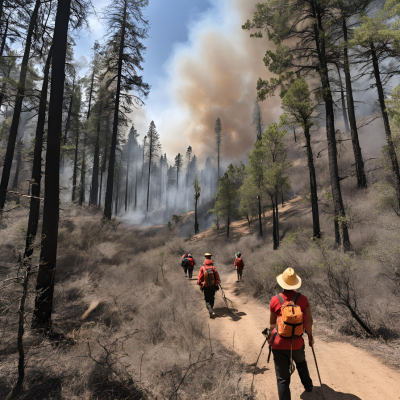
Protection from fires requires the cooperation of many institutions and the education of the public about the dangers of fire. Promoting responsible behaviour among tourists is key, as well as introducing stricter regulations on grass burning and other dangerous practices.
These activities should be supported by local authorities, environmental organisations and the media, which have the potential to raise public awareness of the dangers of fires.
Increase in the number of fires as a result of climate change
In recent years we have noticed an alarming increase in the number of fires, which is closely linked to climate change. Increasingly warmer and drier summers are one of the main factors contributing to the occurrence and spread of fire. High temperatures and a shortage of rainfall lead to the drying out of vegetation, which becomes flammable. Dry grasses, shrubs and trees provide excellent fuel for fires, making their occurrence increasingly common.
Global warming, a result of human activity, is a key contributor to these changes. Emissions of greenhouse gases, such as carbon dioxide and methane, are leading to an increase in average global temperatures. These changes affect weather patterns, resulting in longer periods of drought in some regions and more intense rainfall in others. Such extreme weather conditions are becoming more common, which in turn increases the risk of wildfires.
Fires not only damage ecosystems, but also have serious consequences for human health, the economy and the climate. Smoke and air pollution associated with fires can lead to health problems such as asthma and other respiratory conditions. In addition, fires generate huge material losses and fighting them entails additional costs for society and emergency services.
The increase in the number of fires should be taken as a wake-up call for all of us. We need to understand that climate change is a reality that we have to face. It is crucial to take action to reduce greenhouse gas emissions and promote sustainable development. Protecting forests, putting in place effective monitoring and early warning systems for fires, and educating the public about the dangers of fires are essential to minimise the risk of future fires.
In the face of increasing fire risk, international cooperation is also becoming crucial. Countries should exchange knowledge and experience in fire prevention and management. Only by working together can we address this global challenge and protect our planet from the effects of climate change.
Examples of major fires in Greece
Fire in Mati in 2018
The 2018 Mati fire was one of the most tragic events in modern Greek history, shaking both the country and the international community. The incident occurred on 23 July 2018 in the Attica region, east of Athens. The fire spread at a rapid pace, destroying hundreds of homes, killing dozens of people and causing massive material and ecological damage. Below is a detailed description of the tragedy, its causes, the response of the services and its consequences.
On the hot day of 23 July 2018, two fires broke out in the Attica region – one in Kineta, west of Athens, and the other near Penteli, east of the capital. It was the latter fire that caused the tragedy in Mati. Strong winds of up to 100 km/h and high temperatures favoured the rapid spread of the fire. Within hours, flames engulfed the area of the seaside village of Mati, popular with tourists and locals, turning it into a death trap.
Although the exact cause of the fire was not clearly established, it was suspected that it could have been a spark or an uncontrolled bonfire. There has also been speculation of deliberate arson. Reports indicate that there is evidence to suggest that the fire may have been deliberately set, but the case has not been fully investigated.
Service response
The response of the emergency services and authorities to the fire in Mati was widely criticised by both the public and experts. In the initial phase of the tragedy, there was a lack of proper coordination between the various services, which prevented the effective evacuation of residents and tourists from the fire area. The narrow roads that were supposed to serve as evacuation routes quickly became congested, leaving many people stuck in their vehicles or trapped on the beaches from where they had no means of escape.
The situation was exacerbated by the extremely fast speed at which the fire spread. In just an hour and a half, the fire reached the coast, surrounding many people as they tried to escape the flames. The lack of prior evacuation and the chaotic organisation of rescue efforts meant that not everyone had a chance to reach safety. Although helicopters and fire brigade units worked on the spot, the speed of the fire’s spread was so great that their efforts proved ineffective in many cases.
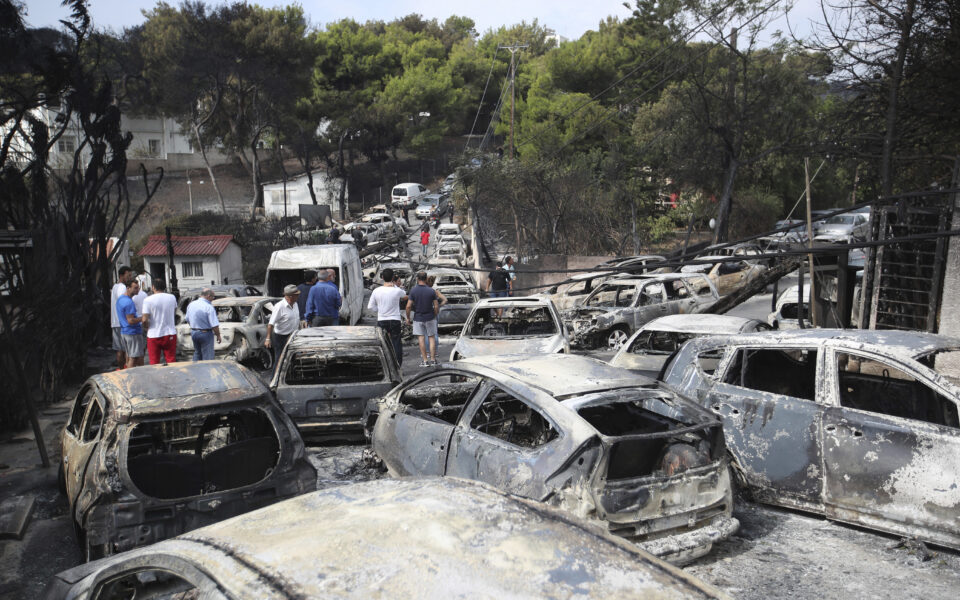
Losses and damage
The impact of the fire in Mati was catastrophic. At least 102 people died as a result of the elements, making this fire one of the most tragic in European history. Most of the victims lost their lives in their homes, cars and also near the coast, trying to escape into the sea. Some people drowned while escaping the flames, while others died from smoke asphyxiation or extensive burns.
In addition to the tragic loss of life, many people suffered serious injuries – some suffered burns to large parts of their bodies, requiring long-term medical care. Animals were also killed in the fire and dozens of hectares of forest and grassland were destroyed. The fire consumed more than 4,000 homes, of which around 1,000 were completely ruined. Hundreds of people were left homeless and many buildings that survived the fire required major repairs.
Environmental and social impacts
The fire in Mati also had far-reaching ecological consequences. The fire destroyed vast tracts of forest, including rare natural habitats, severely affecting local biodiversity. Air pollution in the region has reached dangerous levels, and toxic chemicals released during the fire have adversely affected the quality of water and soil in the area.
Rebuilding the ecosystems will be a long process, requiring many years, and some plant and animal species may never recover.
The disaster shocked Greek society and led to a wide debate on the negligence of fire prevention and the effectiveness of rescue efforts. There was also criticism of urban planning in the Mati region, which made evacuation difficult, due to chaotic buildings and the lack of adequate escape routes. Following the tragedy, the Greek government promised reforms to improve emergency management and prevent similar disasters in the future.
Forest fires in 2021
The year 2021 proved to be one of the most tragic in terms of forest fires in Greece, bringing enormous material, ecological and social losses. As a result of extremely high temperatures, prolonged drought and strong winds, the country was placed in a state of disaster. The island of Evia, which has become a symbol of these fires, was particularly affected, as well as regions such as Attica and the Peloponnese.
The fires, which spread on a massive scale, forced thousands of people to evacuate, led to the destruction of hundreds of homes and caused the loss of priceless natural resources. Greece faced a huge challenge, battling one of the most tragic environmental disasters in its modern history.
The fire broke out in the afternoon of 23 July 2018 and originated on the slopes of Mount Penteli. Gusty winds, reaching speeds of up to 120 km/h, contributed to the rapid spread of the fire. In just a few minutes, the flames reached buildings in Mati and coastal towns such as Neos Voutzas. The fire was moving so fast that residents had no time to evacuate.
The fire trapped hundreds of people in their homes and many tried to flee to the beach, seeking refuge in the sea. Unfortunately, not everyone managed to get there in time. The main evacuation routes were blocked, making escape difficult. The fire cut off the path of many cars, which were stuck in traffic jams, and the flames quickly engulfed the vehicles, causing tragedy.
Situation on the island of Evia
The largest fires covered the northern part of the island of Evia, the second largest island in Greece. The fire on Evia consumed thousands of hectares of forest, especially pine forests, which are flammable and quick to catch fire. Residents of many villages had to be evacuated by sea as land routes were cut off by the fire.
The fires on Evia have also destroyed tourist infrastructure, as well as vineyards and olive groves, which are a vital source of income for the local community. The fire has left the landscape in ruins, destroying not only forest areas, but also houses, roads and local businesses.
Service response
The 2021 forest fires in Greece, including on the island of Evia, posed a huge challenge to Greek emergency services, who struggled to contain the fast-spreading fire. Extreme weather conditions, such as high temperatures, drought and strong winds, meant that the fight against the elements required huge resources and international support. Although the response was ultimately effective, the initial phase received criticism for being too slow to respond.
The fire and rescue services in Greece faced an enormous challenge. Despite the involvement of thousands of firefighters, both local and international, and hundreds of units of equipment, including firefighting aircraft, the difficult weather conditions significantly hampered effective operations. In the first instance, firefighters focused on protecting the population and evacuating villages at risk. Thousands of people, locals and tourists alike, had to leave their homes and resting places to avoid danger.
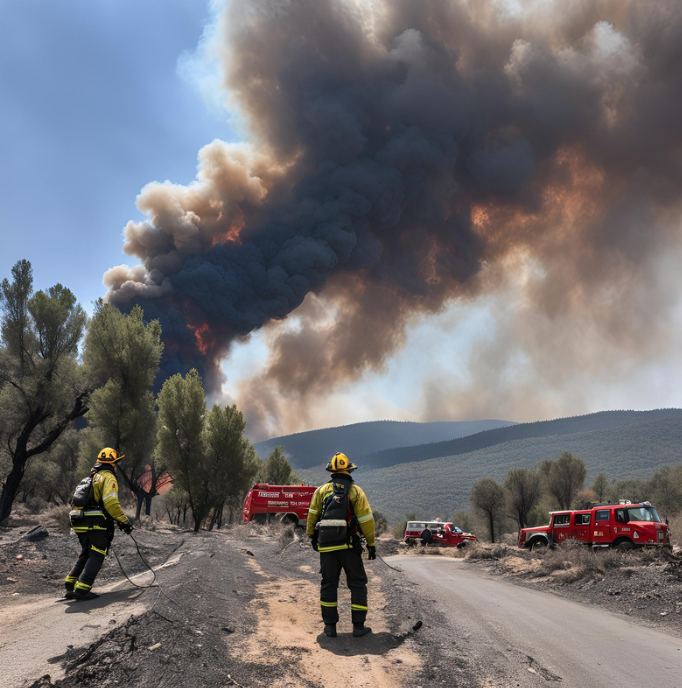
The Greek authorities turned to international partners for help, which proved crucial in fighting the spreading fires. Many European Union countries, such as France, Poland, Romania and Cyprus, were involved in the firefighting operation and sent their firefighting units and equipment.
International cooperation played a key role in limiting the spread of the fires, especially in hard-to-reach areas where local firefighting forces had difficulty operating effectively. The joint efforts enabled better coordination and support in the areas most affected by the fire, which helped to reduce the size of the disaster.
Material and human loss, natural damage
The losses caused by the fires on the island of Evia were immense and had far-reaching consequences for both residents and the environment. More than 50,000 hectares of forest and agricultural land burned, leading to the destruction of many villages. Residents had to flee, leaving all their belongings to the fire. Hundreds of buildings, including houses, farms and tourist infrastructure, were destroyed, drastically affecting revenue from tourism, which is the main source of income for the island.
Despite the mass evacuations, the fires also caused a tragic loss of life. Although most residents were evacuated in time, some were not able to escape the fire, leading to fatalities. Many residents suffered from injuries or health problems related to smoke inhalation.
One of the most severe impacts was the loss of natural resources. The island of Evia, known for its rich pine forests and unique ecosystems, suffered huge natural losses. The fires destroyed wildlife habitats and vegetation crucial to the local ecosystem. These impacts are likely to have a long-term effect on the island’s biodiversity, and the ecosystem will take decades to rebuild.
The loss of forests has also affected the local economy. Timber, which was one of the island’s important raw materials, has been destroyed, resulting in significant financial losses for communities involved in its processing and trade.
Other significant fires in recent years
Samos (2020)
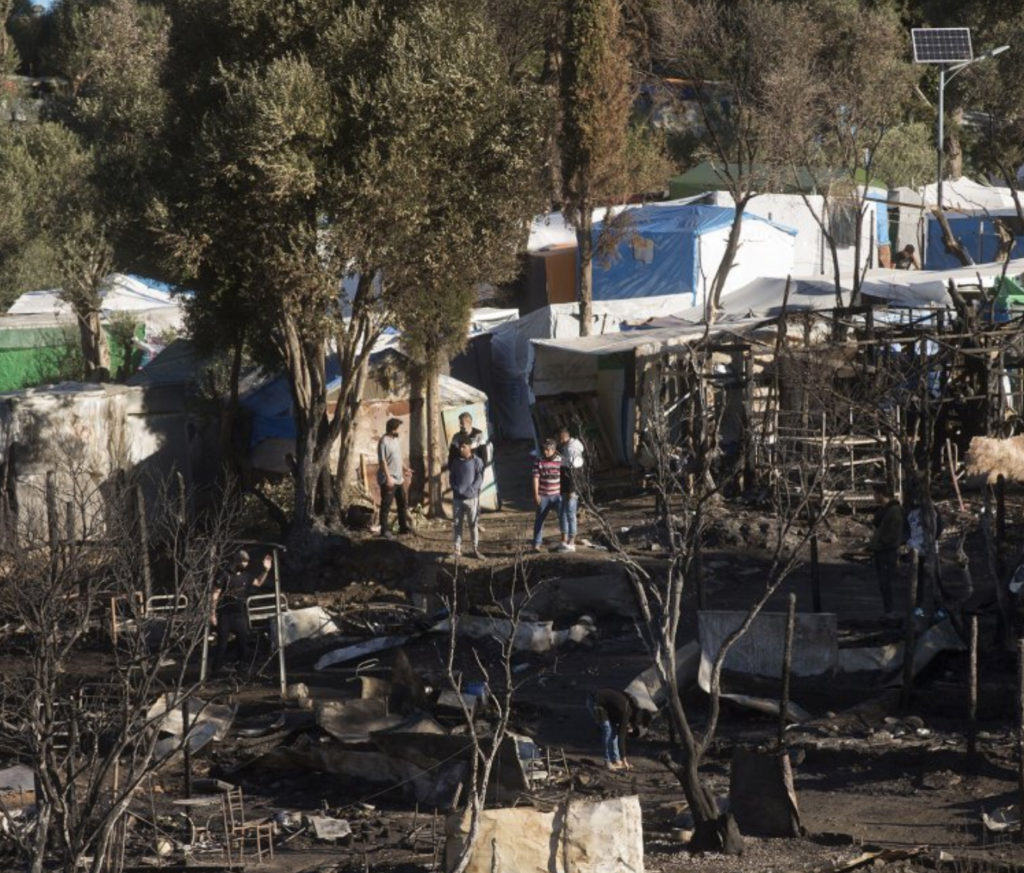
The 2020 fires on the island of Samos caused severe damage and had a long-lasting impact on the local environment. The fire spread mainly in forested areas, but also threatened local settlements. Although the evacuation of residents went smoothly, many hectares of forest were destroyed, with significant consequences for nature.
In April 2020, a series of fires occurred at a refugee and migrant camp on Samos. The island, near the Turkish coast, had become one of the main destinations for refugees seeking refuge in Europe. As a result of the overstretched Greek asylum system, conditions in the camps have become difficult and tensions between residents and refugees, as well as the general humanitarian situation, have led to disturbing incidents, including fires.
These incidents revealed inadequacies in crisis management and the need for better organisation in the camps. It became necessary to take measures to improve living conditions in the camps and to minimise the risk of further tragedies, both related to the fires and to overall crisis management in the context of the refugee crisis.
The fires occurred at the ‘Vathy’ refugee camp on the island of Samos on the night of 26-27 April 2020. The fire broke out in several places in the camp and the cause was not immediately clear. The fires spread quickly in the overcrowded camp, which housed thousands of people despite being many times over its capacity.
The fire destroyed many makeshift tents and shelters, forcing hundreds of refugees to evacuate. Although most people were not seriously injured, many lost their temporary homes and personal belongings. The destruction exacerbated an already difficult humanitarian situation in the camp, where living conditions were already unbearable due to overcrowding and lack of adequate resources.
The situation in the Vathy camp required urgent action, both in terms of humanitarian assistance and improving the living conditions of the refugees, in order to prevent similar tragedies in the future.
Peloponez (2007)
In 2007, a series of fires in the Peloponnese proved to be one of the most devastating in Greek history. More than 250,000 hectares of forest and agricultural land burned and the fire claimed the lives of around 70 people.
The cause of this tragedy was a series of arson fires, as well as drought and high temperatures, which encouraged the rapid spread of the fire. The situation was further complicated by strong winds, which compounded the effects of the fire. These fires not only had tragic consequences for the population, but also caused severe damage to the region’s ecosystems, destroying wildlife habitats and threatening local communities that relied on agriculture and tourism for their livelihoods.
These events have served as a resounding warning of the need to improve emergency management systems and preventive measures in the face of increasingly extreme climatic conditions.
Analysis of causes, losses and long-term effects on the environment
The main causes of fires in Greece are extreme weather conditions, climate change and human activity, both intentional (arson) and accidental. Long-term effects of fires include the destruction of unique ecosystems, soil degradation and negative impacts on biodiversity.
In addition, fires have serious consequences for local communities, including loss of property, risk to human life and long-term health problems caused by air pollution. Authorities are trying to implement prevention strategies such as educating residents, improving fire infrastructure and monitoring areas at risk.
International cooperation and the exchange of experience in disaster management are key to combating this growing problem. In the face of climate change, it is also important to raise public awareness of environmental protection and the need to take action for sustainable development.
How Greece is fighting fires
Preventive measures
Fire prevention measures are a key element in ensuring safety in residential, commercial and industrial buildings. Fire prevention encompasses a range of measures and practices that aim to reduce the risk of fire outbreaks and minimise their impact.
The most important preventive measures include:
Regular maintenance of electrical and heating installations, which are often a source of danger.
Use of fire-resistant materials and securing the premises with smoke detection systems and automatic fire extinguishing systems.
Education and training in fire safety rules for residents and employees also play a key role in fire prevention.
Developing and regularly updating evacuation plans, to ensure a smooth and safe exit from the building in the event of an emergency.
These measures can minimise the risk of fire and protect life and property.
Fire monitoring
Fire monitoring is a key element of environmental protection , public safety and emergency management. Fire monitoring systems use advanced technologies such as:
- satellites
- drones
- thermal imaging cameras
- smoke detectors
These technologies make it possible to quickly detect fire outbreaks and track their development. They make it possible not only to quickly alert the emergency services, but also to analyse data in real time, enabling better planning of rescue operations and minimising losses.
Automation and the use of artificial intelligence in the monitoring process contributes to reducing response times and increasing the effectiveness of operations. In an era of climate change, which is increasing the risk of forest fires, effective monitoring is becoming an essential tool in the fight against this destructive element.
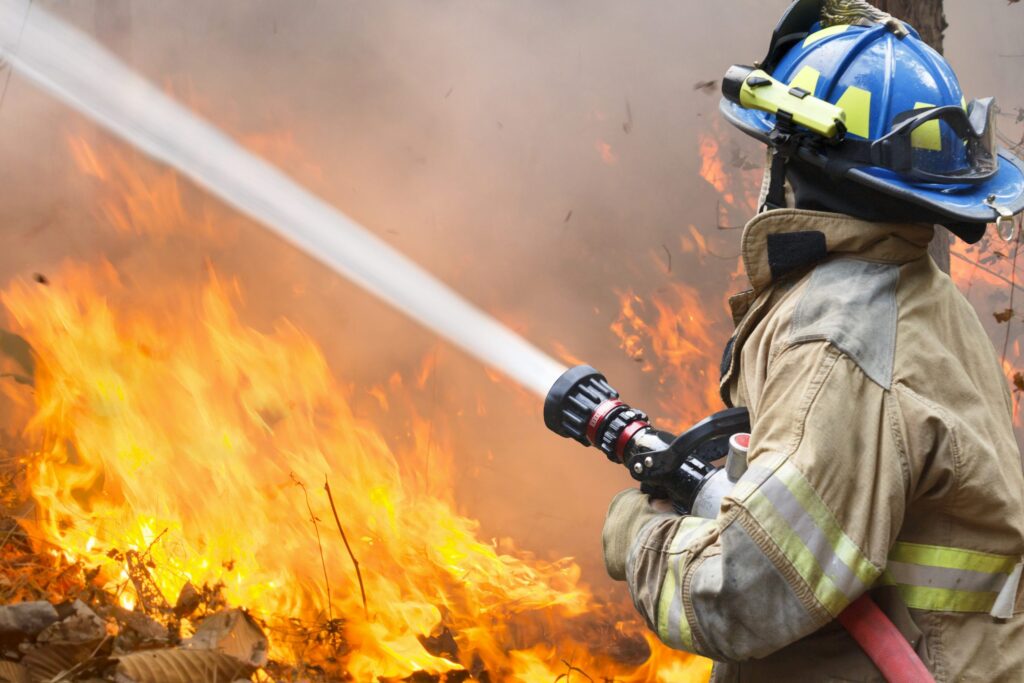
Emergency services
The organisation of the fire brigade in Greece is a key element of the country’s fire protection system, which struggles with frequent forest fires, especially during the summer. The Greek fire brigade, known as ’Πυροσβεστικό Σώμα’(Pirosvestiko Soma), is under the Ministry of Citizen Protection and consists of several specialised units, including technical and chemical rescue units.
Firefighters are responsible for firefighting, rescue, and prevention and education activities. During the summer season, when the risk of fires is at its highest, the Greek Fire Brigade collaborates with other services, international organisations and local communities to respond effectively to hazards.
Technology, including drones and satellites, is playing an increasingly important role in monitoring and predicting fires, significantly increasing the effectiveness of rescue and prevention efforts.
Early detection systems
In Greece, early fire detection systems play a key role in protecting against forest fires, which are particularly dangerous in the region. The country uses various technologies such as satellites, drones and sensors mounted in strategic locations to monitor temperature and smoke.
These systems enable the rapid identification of fire outbreaks, allowing the fire brigade to respond more quickly. In addition, Greece cooperates with other countries in international programmes to develop and improve these systems.
The use of information and communication technologies also supports local communities, who can report hazards in real time. The overall aim is to minimise losses and protect residents and the environment.
European Union
International cooperation and European Union support for firefighters in Greece play a key role in the fight against forest fires. The EU grants funds for the development of response capabilities, which includes the purchase of equipment and training for firefighters.
Greece also benefits from the EU Civil Protection Mechanism, which enables cooperation with other countries in emergency situations. In addition, EU-funded research projects focus on innovations in fire risk management.
These activities not only support the efficiency of fire brigades, but also increase the safety of residents and the protection of the environment.
How to behave during a fire
Personal safety
During fires, it is crucial to keep a cool head and recognise the danger properly so that you can react quickly and protect lives. Forest and residential fires can develop dynamically, so it is important to understand the warning signals and act according to plan.
How do you recognise danger? Warning signals
Fire danger can be recognised by several characteristic signals. First of all, look out for smoke, which can indicate the proximity of a fire, even if the fire itself is not yet visible. Smoke is usually white or grey in colour, but becomes darker as it approaches the source of the fire. Another warning sign is the smell of burning, which can be smelt from a distance. In case of strong winds, a fire can spread very quickly, so it is also important to monitor meteorological information.
Greece has a fire warning system in place through emergency sirens and radio and TV announcements. Local authorities often inform residents of impending dangers through text messages sent to mobile phones. Respond promptly to all warnings and recommendations from the emergency services.
What steps to take when a fire is approaching a residence
If a fire is approaching a residence, the most important thing is to act quickly and thoughtfully.
Above all, stay calm and be prepared to evacuate. If possible, it is a good idea to turn off the gas and electricity supply, which can reduce the risk of an explosion. Keep windows and doors closed to prevent smoke and fire from entering the building.
It is also important to ensure easy access for the fire brigade. If time permits, remove any flammable items from around the house, such as firewood, garden furniture or dry leaves, which could contribute to the spread of the fire.
Evacuation and firefighting
Evacuation is a key element in protecting lives in the event of a fire. A quick and well-organised evacuation can save the lives of both people and animals.
Before an emergency occurs, it is a good idea to plan an evacuation route and carry out a trial evacuation with your family. The route should be as short as possible and lead to a safe location away from potential hazards such as forests or fields. If possible, avoid driving through wooded areas as they may already be covered by fire.
Have an evacuation kit ready, which should include essentials such as documents, money, water, food, a first aid kit and a torch. It is also important to take a charger for your phone and other communication devices that may be necessary during an emergency.
During an evacuation, special attention should be paid to children, the elderly and pets. Children may be stressed and confused, so it is important to keep them calm and control their behaviour. Elderly people may require extra help to get around, so it is essential to make sure that all family members have enough time to evacuate.
For pets, it is a good idea to prepare carriers and leashes to make it easier to control the animals during the evacuation. Animals may react to stress, so care should be taken to ensure that they do not escape
What to do if escape is impossible
If escape from the fire is not possible, seek shelter in a building that can provide adequate protection.
It is advisable to choose a room with solid walls, with as few windows as possible , which can be sealed to prevent smoke from entering . If possible, hide low to the floor, as smoke rises upwards.
It is also important to stay in contact with the emergency services and wait for help. It can be helpful to have a mobile phone with you so that you can communicate your location and get directions if necessary.
Tips for protecting your home and possessions
How do you protect your home from fire?
One of the basic steps that can be taken is to use fire-resistant building materials when building or retrofitting a house.
The roof should be made of fire-resistant materials such as sheet metal or clay tiles. It is also important to install a fire alarm system that will automatically activate if a fire is detected.
In addition, it is a good idea to ensure that windows and doors are properly sealed to limit the passage of smoke into the building. Regular inspection and maintenance of electrical and heating installations also contributes to safety.
Creating a protective space around the house
It is advisable to create a so-called ’buffer zone’ around the house that is free of flammable materials.
Remove dry leaves, branches and other organic waste from the garden regularly. It is also a good idea to prune trees and shrubs so that branches do not come into contact with the building.
Garden plants should be selected with fire resistance in mind – avoiding shrubs that burn easily can significantly reduce the risk. It is also a good idea to use garden materials that are less likely to ignite, such as stone or gravel, rather than wood or composites.
Natural losses: fauna and flora
Flora
Flora includes all plant species found in an area. Plants are a fundamental part of any ecosystem as they produce oxygen, make food (through photosynthesis) and also create habitats for many animal species. Plants act as producers in an ecosystem, meaning that they form the basis of the food chain.
Like fauna, flora can be classified according to:
- Geographical origin – e.g. flora of Europe, tropical flora, flora of the Tatra Mountains.
- Environmental – e.g. aquatic flora (e.g. aquatic plants), arid flora (e.g. cacti in deserts).
- Plant type – e.g. trees, shrubs, herbs, grasses, mosses.
Different ecosystems on Earth have their own specific types of flora. For example, rainforests are characterised by lush, diverse vegetation, including tall trees, creepers and orchids, while deserts are home to drought-tolerant plants such as cacti.
Fauna
Fauna refers to all animal species inhabiting a particular environment, whether wild or farmed. Animals play a variety of roles in ecosystems, including as predators, prey, herbivores or scavengers, which affects the maintenance of biological balance. Animals can also influence the dispersal of plant seeds, as well as the pollination of flowers (e.g. bees).
Fauna can be classified according to various criteria, such as:
- Geographical – e.g. tropical, arctic, European fauna.
- Environmental – e.g. forest fauna, marine fauna, desert fauna.
- Taxonomic – including specific groups of animals, e.g. mammals, birds, insects.
Each region of the world has its own distinctive fauna. For example, the African savannahs are dominated by large mammals such as lions, giraffes, elephants, while in polar regions such as the Arctic, the fauna consists mainly of species adapted to low temperatures, e.g. polar bears, seals, walruses.

Relationship between fauna and flora
Fauna and flora are closely linked. Animals depend on plants as a source of food (e.g. herbivores), and some animals (such as insects or birds) help plants through pollination or seed dispersal. Plants, in turn, benefit from the activities of animals that enrich the soil (e.g. through organic decomposition) and influence nutrient cycles.
Maintaining a balance between fauna and flora is crucial to the health of any ecosystem. Changes in one element (such as the extinction of an animal or plant species) can have far-reaching effects on the ecosystem as a whole.
Impact of fires on biodiversity
Forest and wildland fires have a devastating impact on biodiversity, destroying habitats, killing animals and destabilising ecosystems. Depending on the intensity and extent of the fires, the impacts can be felt locally as well as globally.
The first impact of fires is the loss of habitat for wildlife. As a result of burning vegetation, animals lose their natural shelters, food sources and breeding sites. Species that depend on specific habitat conditions, such as trees or shrubs, can be particularly vulnerable to extinction. For some animals, such as mammals, birds or insects, the lack of suitable habitat means a drastic reduction in their populations. The impact of fires on biodiversity is greater the more intense the fire, and the more difficult it is for the ecosystem to recover, the more long-lasting the damage.
Another problem is species at risk of extinction due to fires. In regions where fires are frequent and intense, such species may not be able to escape or adapt to changing conditions. An example is the koalas in Australia, which lose not only shelter but also the eucalyptus trees that are their only source of food as a result of bushfires. Other species may face a loss of genetic diversity, hampering their ability to survive in changing environmental conditions.
Fires also have a negative impact on ecosystem balance. Ecosystems are complex networks of relationships between organisms that coexist and influence each other’s existence. When a fire destroys a section of an ecosystem, such as a layer of forest litter that shelters many insects and microorganisms, the entire food chain can be affected. The reduction of one species can lead to an increase in its natural predators or to the spread of invasive plants that disrupt the natural order.
The long-term effects on vegetation and the landscape are diverse and depend on the intensity of the fire and the type of ecosystem. In some cases, plants may be able to recover quickly through natural mechanisms such as seed germination after contact with fire. However, in other cases, regeneration may take decades or even centuries. Changes to the landscape after a fire are often irreversible, especially if the fire leads to soil erosion, changing the chemical composition of the soil, making it difficult for new plants to grow.
How does fire change the landscape? Ecosystem regeneration after fires
Fire significantly shapes the landscape, changing the vegetation structure and topography of the land. The short-term effects of fire are usually dramatic: trees and shrubs are burnt, the soil is stripped of its protection and the whole area becomes barren. In the long term, however, this process can lead to the formation of new ecosystems.
As a result of fire, many plants die, but some plant species are adapted to survive such extreme conditions. An example is pyrophilous plants, which thrive after fires because fire activates their seeds to germinate. Nevertheless, the process of ecosystem regeneration after fires depends on many factors, such as the type of ecosystem, climatic conditions and the degree of damage. In the case of dry ecosystems such as savannas or steppes, regeneration can take a relatively short time, from a few years to a few decades. By contrast, in rainforests or other humid regions, regeneration can be much longer and more complicated.
Fire also affects forests, crops and natural resources. The destruction of forests not only deprives animals of shelter, but also affects timber resources, which are a valuable resource. Fires can also destroy agricultural crops, leading to losses in food production and farmers’ income. Loss of vegetation and changes in soil composition can also affect water resources, as plants play a key role in water retention and erosion prevention.
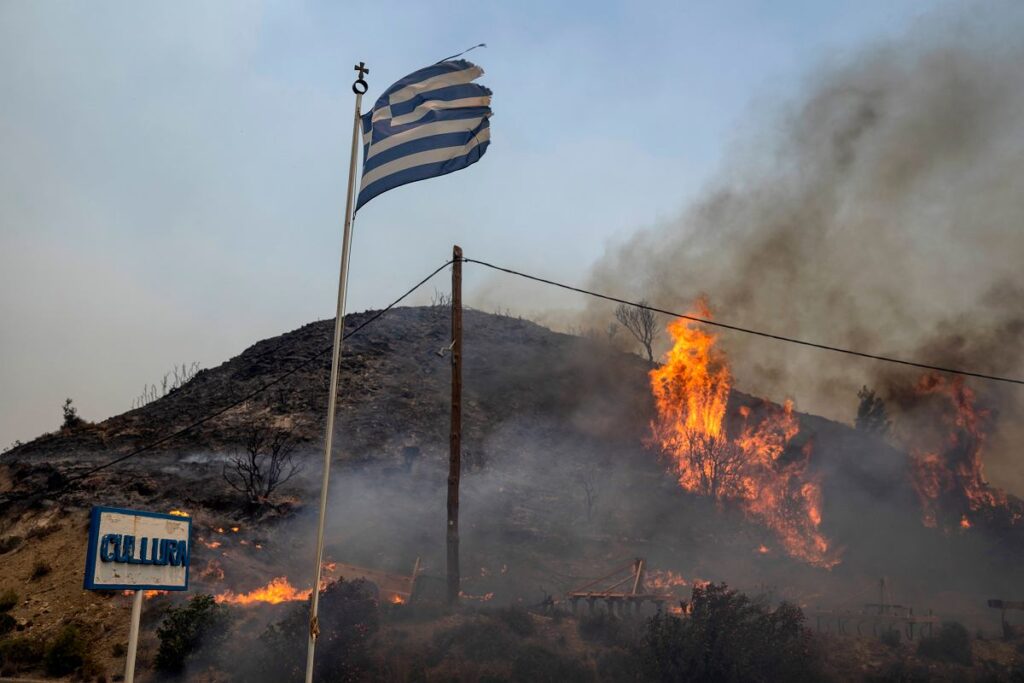
The importance of protecting and restoring fire areas
The regeneration of burned areas is a key element of environmental protection. Without appropriate regeneration measures, ecosystems may not recover their original diversity and function. Reforestation and natural ecosystem restoration projects aim to restore vegetation and create conditions for the return of animals. Planting fire-resistant trees and soil restoration are important elements of these activities.
International organisations such as WWF support local initiatives by providing resources and funds for conservation projects. International support for nature conservation after wildfires is of great importance, especially in developing countries where resources for ecosystem restoration are limited. Effective action can help reduce the risk of future fires and ensure long-term conservation of nature.
Summary and conclusions
How can we reduce the risk of future fires?
Reducing the risk of fires requires coordinated action at many levels, including:
Variability in environmental policy, which should include forest land management, control of human activities and promotion of sustainable development.
Increased prevention activities, such as public education, regular inspection and maintenance of installations and infrastructure, and the creation of buffer zones around fire-prone areas.
Increased international cooperation, which will enable the exchange of experience and technology, as well as support in emergency situations.
As a country with a hot climate and rich biodiversity, Greece needs to take special measures to protect its natural resources and communities. It is crucial to develop innovative technological solutions that support the monitoring and early detection of fires, as well as involving local communities in environmental protection efforts.
Changes in environmental policy
In order to fight fires effectively, changes in environmental policy are needed that prioritise:
Forest protection: The introduction of strict regulations for the protection of forested areas, especially in fire-prone areas, can significantly reduce the occurrence of fires.
Sustainable management of natural resources: This includes restrictions on the construction of infrastructure near forests and the introduction of regulations for the management of waste, which is a frequent cause of fires.
Proactive measures: It is also necessary to strengthen surveillance of areas where illegal vegetation burning regularly occurs. In addition, conducting regular information campaigns that make local communities aware of the dangers of fires can help to reduce the number of incidents.
Collaborating with NGOs and international institutions to implement effective environmental strategies and monitor the situation in forests is also a key element in the fight against fires.
Enhanced prevention activities and international cooperation
Prevention measures are key to minimising the risk of fires. In Greece, investment should be made in monitoring and early-warning systems that allow for the rapid identification of risks. Technologies such as drones, satellites and artificial intelligence can play a key role in detecting fires at an early stage, allowing emergency services to respond more quickly.
Increasing international cooperation is another important element in the fight against fires. Cooperation within the European Union and with other countries affected by fires makes it possible:
Rapid dispatch of emergency assistance and equipment, which is essential for large fires that can quickly get out of control.
The exchange of experience and technology between countries, with significant benefits in terms of prevention and emergency management. Such activities can include joint exercises, training for firefighters and the development of innovative firefighting technologies.
An integrated approach that combines cutting-edge technologies with international cooperation is key to effective firefighting in Greece and around the world.
Education of the public and involvement of individuals
Last but not least is the education of the public. Awareness campaigns to make citizens aware of fire hazards and safety rules can significantly affect their preparedness to respond to emergencies.
Education should include:
Children and young people: Introduce educational programmes in schools that teach about the causes of fires, the effects on the environment and how to act in case of danger.
Adults: Organise workshops and seminars for local communities to discuss best practice in fire safety, including how to avoid activities that increase the risk of fires.
The wider community: Participation in community campaigns that promote responsible behaviour, such as the proper handling of fire near forests or the elimination of flammable materials from the environment.
Important elements of education:
Information on local risks: Enabling residents to better understand the specific risks in their regions.
Preparing for evacuation: Training in the development of evacuation plans and emergency response so that residents are prepared to respond quickly.
Educating the public is a key element in building a culture of safety, which translates into making local communities more resilient to fire hazards.
Impact of the fires on the future of the region and society
How are fires changing the lives of local communities?
Local communities, especially in rural areas, experience the most severe consequences of fires. In addition to direct material losses such as the loss of homes, farm buildings and infrastructure, fires also have long-term social and psychological consequences.
Direct consequences:
Loss of sources of income: Residents lose farmland, forests and other natural resources that are often the basis of their livelihoods. This leads to financial hardship and, in some cases, forces them to migrate in search of new opportunities.
Evacuation of villages: In extreme cases, entire communities have to be evacuated, disrupting their lives and social ties. Such a crisis leads to a sense of powerlessness and frustration among residents.
Long-term consequences:
Changes in social structure: Evacuations and destruction can lead to community fragmentation, which weakens interpersonal ties and trust.
Psychological problems: The loss of homes and close places affects the psychological state of residents. Many people struggle with trauma, depression and anxiety about the future, requiring additional psychological support.
Destruction of local ecosystems: The local ecosystem, which is part of the cultural identity of the inhabitants, is also being destroyed. With the loss of forests, animals and natural landscapes, communities lose not only their places to live, but also their natural heritage. This can lead to the impoverishment of local culture and traditions associated with nature.
Community recovery:
After fires, communities need support to rebuild, both physical infrastructure and social relationships. It is important that reconstruction efforts are sustainable and take into account local needs and cultural values, which can help the long-term regeneration of these areas.
Long-term climate change and the risk of wildfires in Greece
Climate change is leading to increased temperatures and longer periods of drought, which favours fire outbreaks. Increased global temperatures, reduced rainfall and intensification of extreme weather conditions may increase the frequency and strength of fires in Greece in the coming years. We are already seeing how climate change is affecting regions such as the Greek islands, where fires are becoming an increasingly frequent threat.
The impact of climate change on fires in Greece:
Increased temperatures: Higher temperatures favour the drying out of vegetation, which increases its flammability. This phenomenon, combined with strong winds, can lead to rapid fire spread.
Long-term droughts: Reduced rainfall causes soils to become drier, further encouraging fire outbreaks. In regions where water is already limited, the situation becomes even more critical.
Extreme weather events: Intense storms, winds and other phenomena can cause sudden and unpredictable fires that are difficult to control.
Strategy adaptation:
Greece will therefore need to adapt its environmental, emergency management and prevention strategies to the new reality in which climate change will play a key role.
Investment in infrastructure: Increasing investment in fire infrastructure and fire monitoring systems, including the use of drones and satellites, can help to respond to hazards more quickly.
Education and community engagement: It is important that residents are aware of the risks and know the principles of safety and prevention. Educational campaigns can help build local communities that are more resilient to fires.
International cooperation: Increasing cooperation with other countries, especially within the European Union, will allow for the exchange of experience and technology in fighting fires. Such activities may include joint exercises and rescue operations.
Sustainable ecosystem management: Protecting and regenerating local ecosystems, which are key to biodiversity and environmental health, can help reduce the risk of wildfires.
Adapting to climate change and responding appropriately to the increasing threat of fires is key to protecting the population, the environment and natural resources in Greece.

